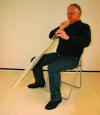Didgeridoo playing as alternative treatment for obstructive sleep apnoea syndrome: randomised controlled trial
- PMID: 16377643
- PMCID: PMC1360393
- DOI: 10.1136/bmj.38705.470590.55
Didgeridoo playing as alternative treatment for obstructive sleep apnoea syndrome: randomised controlled trial
Abstract
Objective: To assess the effects of didgeridoo playing on daytime sleepiness and other outcomes related to sleep by reducing collapsibility of the upper airways in patients with moderate obstructive sleep apnoea syndrome and snoring.
Design: Randomised controlled trial.
Setting: Private practice of a didgeridoo instructor and a single centre for sleep medicine.
Participants: 25 patients aged > 18 years with an apnoea-hypopnoea index between 15 and 30 and who complained about snoring.
Interventions: Didgeridoo lessons and daily practice at home with standardised instruments for four months. Participants in the control group remained on the waiting list for lessons.
Main outcome measure: Daytime sleepiness (Epworth scale from 0 (no daytime sleepiness) to 24), sleep quality (Pittsburgh quality of sleep index from 0 (excellent sleep quality) to 21), partner rating of sleep disturbance (visual analogue scale from 0 (not disturbed) to 10), apnoea-hypopnoea index, and health related quality of life (SF-36).
Results: Participants in the didgeridoo group practised an average of 5.9 days a week (SD 0.86) for 25.3 minutes (SD 3.4). Compared with the control group in the didgeridoo group daytime sleepiness (difference -3.0, 95% confidence interval -5.7 to -0.3, P = 0.03) and apnoea-hypopnoea index (difference -6.2, -12.3 to -0.1, P = 0.05) improved significantly and partners reported less sleep disturbance (difference -2.8, -4.7 to -0.9, P < 0.01). There was no effect on the quality of sleep (difference -0.7, -2.1 to 0.6, P = 0.27). The combined analysis of sleep related outcomes showed a moderate to large effect of didgeridoo playing (difference between summary z scores -0.78 SD units, -1.27 to -0.28, P < 0.01). Changes in health related quality of life did not differ between groups.
Conclusion: Regular didgeridoo playing is an effective treatment alternative well accepted by patients with moderate obstructive sleep apnoea syndrome. Trial registration ISRCTN: 31571714.
Figures
References
-
- Caples SM, Gami AS, Somers VK. Obstructive sleep apnea. Ann Intern Med 2005;142: 187-97. - PubMed
-
- Duran J, Esnaola S, Rubio R, Iztueta A. Obstructive sleep apnea-hypopnea and related clinical features in a population-based sample of subjects aged 30 to 70 yr. Am J Respir Crit Care Med 2001;163: 685-9. - PubMed
-
- Young T, Palta M, Dempsey J, Skatrud J, Weber S, Badr S. The occurrence of sleep-disordered breathing among middle-aged adults. N Engl J Med 1993;328: 1230-5. - PubMed
-
- White J, Cates C, Wright J. Continuous positive airways pressure for obstructive sleep apnoea. Cochrane Database Syst Rev 2002;(2):CD001106. - PubMed
-
- Marin JM, Carrizo SJ, Vicente E, Agusti AG. Long-term cardiovascular outcomes in men with obstructive sleep apnoea-hypopnoea with or without treatment with continuous positive airway pressure: an observational study. Lancet 2005;365: 1046-53. - PubMed
Publication types
MeSH terms
Associated data
LinkOut - more resources
Full Text Sources
Other Literature Sources
Medical




